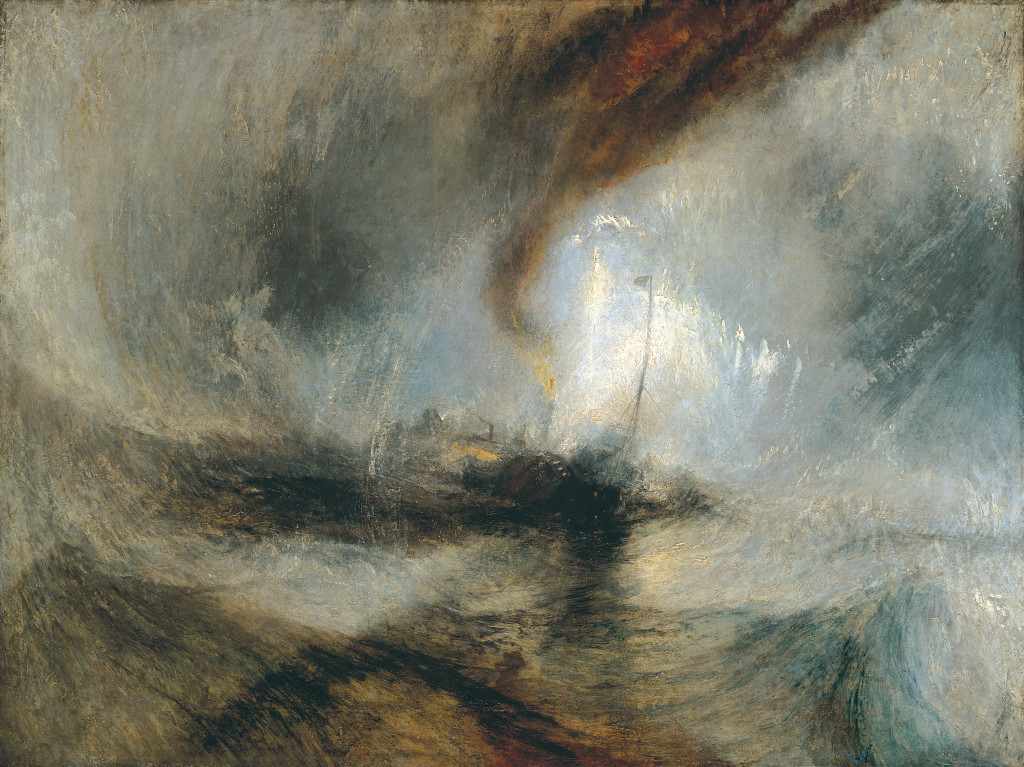
And then the sun passed above the skyline, so the cliffs were ablaze with light and he had shadows to paint again. In the green water, fishermen readied their boats and waves churned up froth and fish. He picked up his brush. There’s no wind at all but a familiar strangeness collecting. Day again.
Of J.M.W. Turner’s later works biographer Walter Thornbury wrote, “I am no defender. They are dreams, challenges, theories, experiments, and absurdities.” Turner, who began exhibiting his paintings in his father’s barbershop as a young boy, was a pillar of England’s Royal Academy for much of his adult life. But by the 1840’s, critics agreed that Turner was losing his sight and/or his marbles. He was old, after all, and exceedingly eccentric. Why else would England’s best-loved Romantic artist let the black smoke of an approaching steamer choke up the whole horizon? Or disguise the Alps in blizzard, to the point of erasure?
Of course today’s scholars hold Turner’s abstraction in high esteem. For his fidelity to sentiment, Turner is considered a proto-Impressionist. For his rejection of form, a prophetic genius. The end of his life is remembered as the beginning of modern art.
Turner’s old age is also the subject of Mike Leigh’s exquisite new film “Mr. Turner,” which works like one of its protagonist’s landscapes—with both tender attention to detail and a sense for the sublime. The movie, like its subject, is peculiar: devoid of plot and yet engrossing, totally gorgeous and then almost offensive to behold.
Leigh’s gift is for realistic social portraiture (as in his 1999 film “Topsy-Turvy about Gilbert and Sullivan), but in “Mr. Turner,” the natural landscape steals the show. We are made to look on the ocean as Turner would have, standing on the shores of a lake or the top of a mountain, pencil and notebook in hand.
Time after time he came back to his studio and opened the window, asked for water. Sunlight hung like a curtain, and the air, spotlighted, admitted its dust. He furrowed his brow and mixed a new green. For this shipwreck, in particular, the ocean needed to be sculpted. He began in globs then slashes. He coughed and spit and scraped with his nails.
There is discomfort in watching Turner (Timothy Spall) move through the world. In every room he enters—from his own kitchen to the halls of the Royal Academy of Arts—he snorts and harrumphs and sniffles. His chin and neck are indistinguishable, and his teeth, by the end, go green.
At the beginning of the movie, Turner’s father goes out to the market and comes home with a prize porker for his son’s dinner. In the scenes that follow, Turner behaves the way he looks—like a pig. He grabs his housekeeper’s breasts by way of greeting. He fucks her unceremoniously, without so much as a grunt of thanks. And he misses his daughter’s funeral because he “didn’t find [him]self in the city.”
So “Mr. Turner” is a film in which the artist is a body and the genius is an animal—but it’s also not so simple. Turner is a man. He is the sum of parts that don’t easily fit together, a personality dominated more by paradox than any single trait. At times, he is raw, tender, and completely available to the people around him, as in his romance with the delightful Mrs. Boothe, a widowed landlady in Margate. Each winter draws the closer; a soft warmth moves between them.
But even when living with Mrs. Boothe, Turner remains first and foremost a wanderer. He stays obsessed with the landscapes that forget us—mountains and lakes, meadows and seas. He spends his last years living on the edge of things, savoring the wilderness that society tends to push to its peripheries. When he dies, in 1852, he has already painted the future: the blur of a steam train, streaking across the river Thames.
Turner’s stubborn zeal for new frontiers—for the as-yet-unnamed, unmapped, and untraveled—drove him to scrap convention and embrace abstraction. As it turns out Thornbury was right despite himself: only by daring to explore and experiment did Turner alter our very definition of art.
Likewise, “Mr. Turner” is not a biopic, per se: Leigh does not try to account for every square inch of his painter’s life or put forth a general theory of his character. Instead, his project is founded in humility. At every stage in his artistic process, Leigh seems to turn to his historical subject and whispers: “I’m sure there are things about you beyond my understanding.”
The day black clouds collected was also the day the waves swelled, the birds squawked, and a crew of bedraggled sailors reefed their sails. And the painter? He was strapped to the mast of the ship, as the wind gathered speed, as the world went white around him. He lost touch with his fingers. He closed his eyes. And so this is death, he thought: static closing in, then calm. When the snow melted and spring came, an old landlady in Margate tidied her spare bedroom, in case of visitors. With a rag, she scrubbed each windowpane clean and looked outside to see: she knew by then the town, its streets, its harbor, and the ghost ship not far from shore.

susan mccall
January 25, 2015 at 8:39 pm (2 years ago)gillian collins has described “Mr. Turner” perfectly.I had
no idea what a feast for the eyes this movie was going
to be and didn’t want it to end.Every frame was a perfect still life that Gillian so eloquently described.Her writing so mirrored my experience of this film that I must have another “go” pronto.